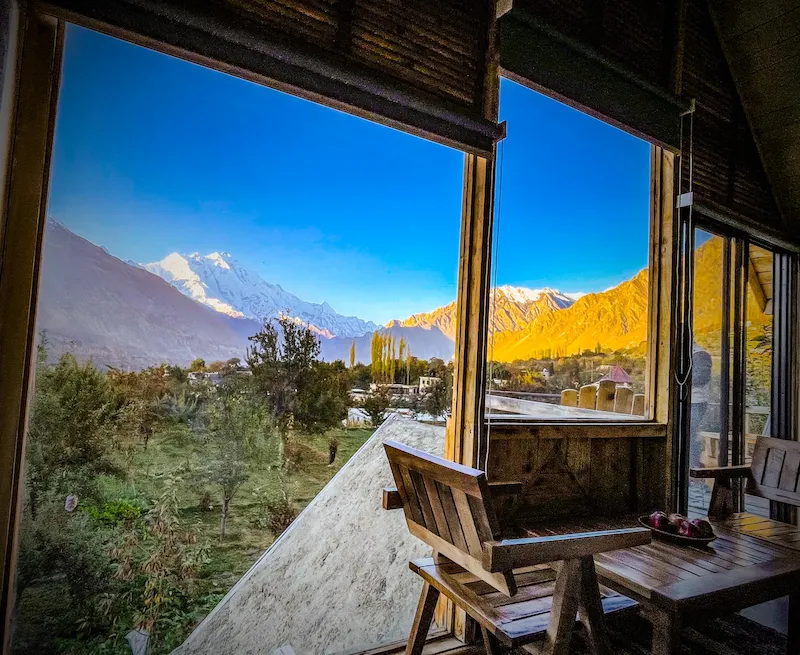Hunza Valley is more than just a destination, it’s a year-round dreamscape. From snow-capped peaks to riverside orchards, from golden autumns to spring blossom festivals, Hunza’s scenery changes dramatically with the seasons.
But if you’re planning a trip, one question always comes first: When is the best time to visit Hunza Valley? The truth is, there’s no single “best” month that works for everyone. The answer depends on what you want from your journey.
Do you want to walk under the archways of cherry blossoms with your partner? Or explore mountain trails and turquoise lakes with your family in summer? Perhaps you’re after golden foliage for your camera lens, or the stillness of a snowy winter for self-reflection.
In this comprehensive guide, you will explore Hunza Valley’s seasons in detail, including weather conditions, best months, trip activities, festivals, and travel tips for families, couples, and adventure seekers.
By the end, you’ll not only know when to go, you’ll also understand why each season has its own magic.
Here are some trip you might be interest in:
- Hunza Cherry Blossom Trip
- Hunza Valley Autumn Trip
- Pakistan Spring Blossom full trip
- Pakistan Winter Tour Package
Understanding Hunza Valley’s Weather & Seasons
Hunza Valley’s beauty changes dramatically with the seasons, from pink spring blossoms to golden autumn foliage, and understanding its weather patterns is the key to planning a trip that matches your dream experience.
Where is Hunza Valley?
Hunza Valley lies in Gilgit-Baltistan, in northern Pakistan, close to the borders with China and Afghanistan. It’s surrounded by towering peaks of the Karakoram Range, including Rakaposhi (7,788 m), Ultar Sar (7,388 m), and Passu Cones (6,106 m).
The valley sits at an altitude of 2,438 meters (7,999 ft) in the central town of Karimabad, with higher villages and passes reaching above 4,500 meters.
Altitude & Climate Impact
Hunza’s altitude means cooler temperatures year-round compared to most parts of Pakistan. Even in summer, nights can be refreshingly cool, while winters can bring heavy snow in higher areas.
The rain shadow effect (caused by surrounding high peaks blocking monsoon winds) makes Hunza relatively dry, with most precipitation in the form of winter snow.
Seasonal Accessibility
- March–November: Roads are generally open, making it easier to access Hunza via the Karakoram Highway.
- December–February: Snow may block access to higher villages and Khunjerab Pass (which officially closes in winter).
Hunza Valley Weather Conditions (Year-Round)
| Month | Avg. Day Temp | Avg. Night Temp | Weather Highlights | Accessibility |
| March | 8°C | -2°C | Snow melting, early blossoms | Open, some high trails icy |
| April | 15°C | 5°C | Cherry & apricot blossoms | Full access |
| May | 20°C | 10°C | Lush green, trekking season starts | Full access |
| June | 25°C | 12°C | Warm days, boating season | Full access |
| July | 27°C | 15°C | Peak summer, trekking, festivals | Full access |
| August | 26°C | 14°C | Monsoon edge, lush landscapes | Full access |
| September | 20°C | 9°C | Start of autumn colors | Full access |
| October | 15°C | 5°C | Peak golden foliage | Full access |
| November | 10°C | 0°C | First snow, quiet season | Access with caution |
| December | 5°C | -5°C | Winter snow, frozen lakes | Limited high road access |
| January | 2°C | -8°C | Deep winter | Limited high road access |
| February | 5°C | -6°C | Winter festivals | Limited high road access |
Best Time to Visit Hunza Valley – Season by Season
Hunza Valley’s magic lies in its changing seasons, each painting the landscape in a new palette and offering unique experiences for travelers.
Here’s a detailed look at what each season offers, so you can choose the one that perfectly matches your travel dreams.
Spring (March to May) — Blossom Season & Hiking Paradise

Spring in Hunza is a visual poem. The valley bursts into shades of pink and white as apricot, cherry, and apple blossoms unfurl against the backdrop of snow-dusted peaks.
The air is fresh, rivers are swollen with snowmelt, and the first signs of greenery return to terraced fields.
Villages like Karimabad, Gulmit, and Passu turn into postcard scenes, and locals celebrate the season with cultural festivals like Navroz (marking the Persian New Year) and blossom fairs.
Ideal for:
- Couples: Stroll hand-in-hand under flowering orchards
- Photographers: Capture rare contrasts of blooming trees and icy mountains.
- Hikers: Low-altitude treks like the Passu Glacier Trail and Rakaposhi Base Camp become accessible.
Activities:
- Attend Hunza Blossom Festival with traditional music, dance, and polo matches.
- Trek to Hopper Valley or explore the cobblestone alleys of Altit and Baltit forts.
- Visit Attabad Lake, still framed by snow-tipped ridges but shimmering with turquoise water.
Weather: Pleasant and mild, ranging from 5°C at night to 20°C during the day. Layers are still recommended in March, but by May, light jackets are enough.
Summer (June to August) — Outdoor Adventure & Lush Scenery
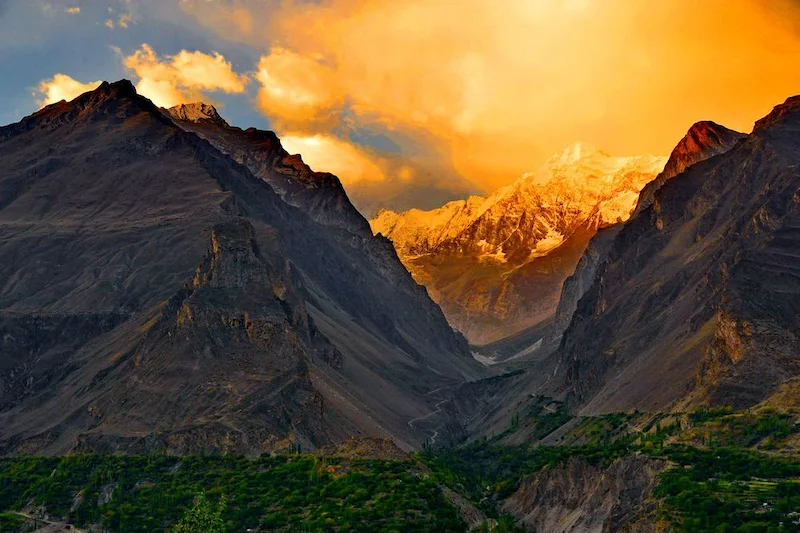
Summer transforms Hunza into a green paradise. Apricot, walnut, and mulberry trees are in full leaf, and the valley floor glows with emerald terraced fields.
This is peak season for Attabad Lake boating, road trips to Khunjerab Pass (the highest paved border crossing in the world), and adventure sports.
Ideal for:
- Family Vacations: Perfect weather, no road closures, and plenty of safe activities for all ages.
- Adventure Sports Enthusiasts: Trekking, mountain biking, paragliding, and rafting opportunities abound.
- First-Time Visitors: Everything is open, from mountain passes to small village markets.
Activities:
- Take a boat ride across Attabad Lake and visit the submerged village remains.
- Drive the Karakoram Highway to Khunjerab Pass for snow in the middle of summer.
- Spot ibex and marmots in Khunjerab National Park.
- Trek to Rush Lake — one of the highest alpine lakes in the world.
Weather: Warm but never uncomfortably hot — 15°C to 30°C — with cool evenings.
Autumn (September to November) — Golden Hunza & Cultural Charm
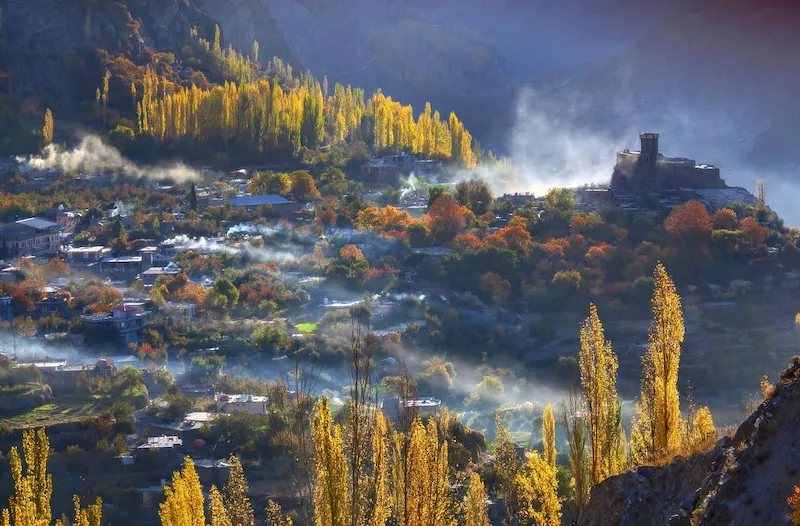
Autumn is Hunza’s most photogenic season. By late September, the valley shifts into deep golds, burnt oranges, and crimson reds as poplars, apricot trees, and willows prepare for winter.
The contrast between fiery foliage and snow-covered peaks is breathtaking, especially at sunset from Duikar or Eagle’s Nest viewpoint.
Ideal for:
- Couples: Romantic backdrops and fewer summer crowds make it ideal for honeymoons.
- Photographers: Dramatic light and color contrast create portfolio-worthy shots.
- Slow Travelers: Enjoy leisurely village stays and immerse yourself in Hunza’s cultural rhythm.
Activities:
- Photography walks in Ganish Village and along the Hunza River.
- Attend local harvest festivals and sample traditional dishes like chapshuro.
- Trek moderate trails like Ultar Meadow or Hopper Glacier without summer heat.
Weather: Crisp and clear, with 5°C mornings and up to 20°C afternoons. By November, frost begins to touch the valleys.
Winter (December to February) — Snow, Serenity & Festivals
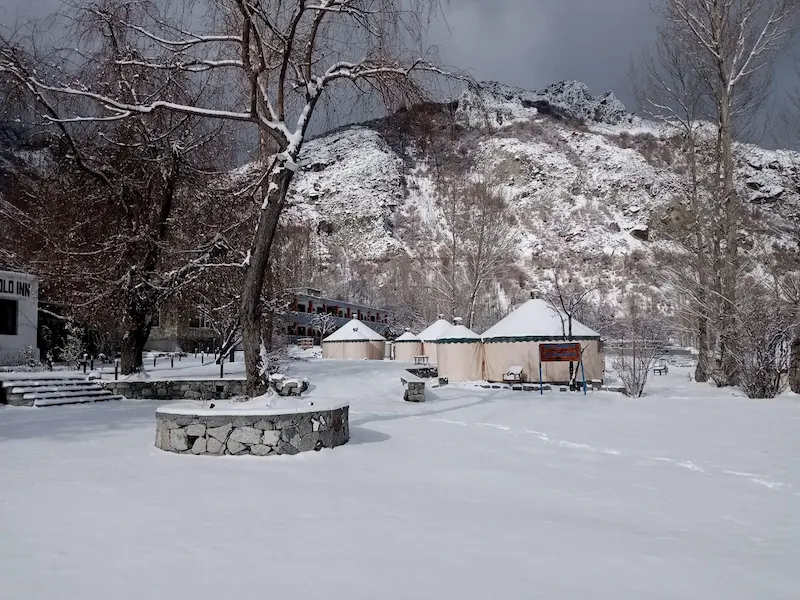
Winter in Hunza is a quiet, almost meditative experience. Snow blankets rooftops, roads, and terraced fields, turning villages into fairytale scenes.
The Hunza River often partially freezes, and waterfalls become icy sculptures. Winter also brings local gatherings and storytelling nights.
Ideal for:
- Snow Lovers: Witness a peaceful, white Hunza without the bustle of tourists.
- Cultural Travelers: Experience Hunza life when it slows down for winter.
- Photographers: Capture rare snow scenes under crystal-clear skies.
Activities:
- Skiing and snow trekking in higher valleys like Shimshal and Hopper.
- Attend Winter Festivals featuring local polo matches and music.
- Join a homestay for fireside tea and Hunza bread, hearing local legends from elders.
Weather: Cold and snowy, with temperatures from -10°C to 5°C. Nights are especially frigid, but the dry air often keeps days sunny.
Accessibility: Limited — higher passes like Khunjerab are closed, and snow can block some roads to remote villages.
Month-by-Month Guide – The Best Month to Visit Hunza Valley
The beauty of Hunza changes every month, offering travelers a different reason to fall in love with it. Here’s a quick month-by-month breakdown to help you choose the best month to visit Hunza Valley based on your travel style.
March:
Snow begins to melt, revealing green terraces and the first apricot buds. Trails are quiet, making it perfect for travelers who enjoy serene landscapes without the crowds.
April–May
The valley turns into a pastel paradise as cherry and apricot blossoms peak. Couples and photographers will find endless romantic and photogenic backdrops.
June–July
Warm days and open roads make these months ideal for families. Adventure activities like trekking, boating on Attabad Lake, and paragliding are at their best.
August
Hunza is lush and vibrant, with waterfalls and rivers in full flow. It’s a sweet spot between summer’s high season and autumn’s rush, meaning fewer tourists.
September–October
Autumn transforms Hunza into a canvas of gold, orange, and red. These are the most romantic months for honeymoons and cozy getaways.
November
Early snow dusts the peaks, and the valley becomes quiet again. A peaceful time for reflective travel and cultural immersion.
December–February
Hunza becomes a winter wonderland with snow-covered villages, frozen waterfalls, and lively winter festivals. Best for snow lovers and cultural explorers.
Best Time to Visit Hunza for Different Types of Travelers
Hunza Valley’s changing seasons make it a destination that can be tailored to any type of traveler, whether you’re a family seeking a safe and scenic holiday, a couple chasing romance, or an adventurer eager to trek remote mountain trails.
Here’s a breakdown of the best times for each type of journey.
Best Time to Visit Hunza with Family
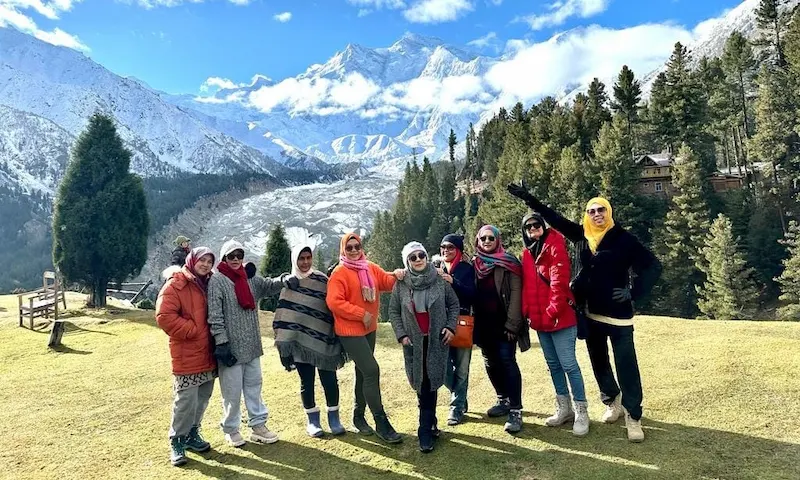
Summer is the most family-friendly season in Hunza. The weather is comfortably warm (15°C–30°C), the skies are clear, and all major routes, including the Karakoram Highway and mountain passes, remain open.
This means you can explore the valley without worrying about sudden snow closures or dangerous travel conditions.
Recommended Months: June–August
Activities for Families:
- Boating at Attabad Lake: Calm turquoise waters, life jackets provided, and plenty of picnic spots along the shore.
- Wildlife Spotting at Khunjerab National Park: Kids can see marmots, Himalayan ibex, and even snow leopards.
- Easy Hikes: Trails like Hussaini Suspension Bridge (mild challenge) and Altit Village walks are fun and safe for children.
- Fruit Picking: Depending on the month, apricots, cherries, or mulberries may be in season.
Safety Tips for Traveling with Kids:
- Avoid very high-altitude areas (above 4,000m) if your children are under 10 to prevent altitude sickness.
- Carry snacks and water — facilities can be limited in remote spots.
- Use sunscreen even in cooler weather; UV is strong at high altitudes.
- Travel with layered clothing as temperature swings between day and night can be significant.
Best Time to Visit Hunza for Couples
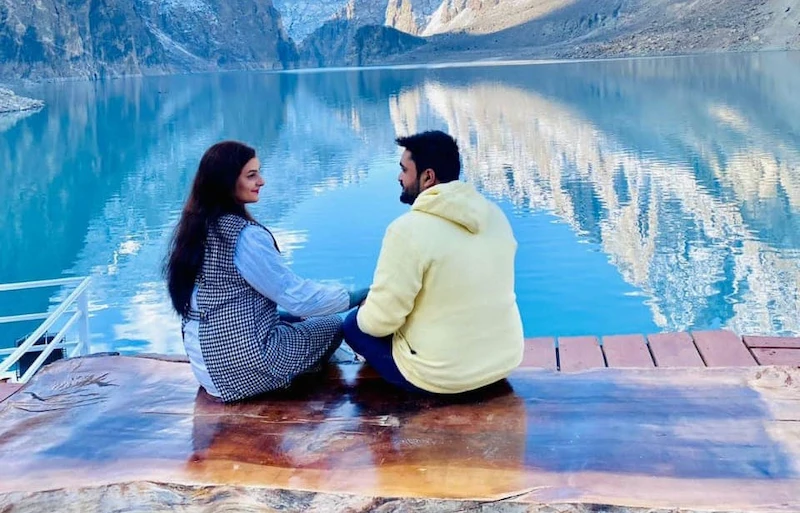
Hunza offers two distinctly romantic moods, spring’s soft blossoms and autumn’s warm golden tones. Spring is perfect for gentle walks under flowering apricot and cherry trees, while autumn sets the valley aglow with fiery foliage framed by snow-capped peaks.
Recommended Months: April–May (blossom season) & September–October (autumn colors)
Romantic Spots:
- Duikar Viewpoint at Sunset: Watch the peaks of Rakaposhi, Ultar Sar, and Ladyfinger bathe in pink and gold light.
- Eagle’s Nest Hotel Terrace: A panoramic vantage point for sunrise breakfasts or starry-night conversations.
- Hoper Valley: Less crowded, with lush meadows and glacier views
Honeymoon Suggestions:
- Book a traditional Hunza house homestay for authentic cultural immersion.
- Take a private boat ride on Attabad Lake at sunset.
- Plan a photography day capturing both landscapes and local village life.
- Combine your Hunza trip with a short stay in Shimshal or Phander Valley for an off-the-beaten-path romantic escape.
Best Season to Visit Hunza for Hiking & Trekking

Spring offers comfortable temperatures and clear views for low-to-mid altitude hikes and treks, while summer opens up the high mountain passes and glaciers for experienced hikers.
Recommended Months: March–May (cooler hikes with spring views) & June–August (high-altitude trekking season)
Best Treks:
- Passu Glacier Trek: Moderate hike with sweeping glacier views and iconic Passu Cones.
- Ultar Sar Base Camp: Challenging day hike starting from Karimabad with close-up views of the massif.
- Rush Lake Trek: One of the highest alpine lakes in the world — best attempted in July or August when snow has melted.
- Rakaposhi Base Camp Trek: Moderate to challenging route with one of the most dramatic mountain backdrops in Pakistan.
Gear Recommendations by Season:
- Spring (March–May): Light down jacket, trekking poles, waterproof boots, and sunglasses for snow glare at higher altitudes.
- Summer (June–August): Breathable layers, sturdy hiking boots, sun hat, high-SPF sunscreen, and water filtration tablets for multi-day treks.
- Always carry a first-aid kit and headlamp, as mountain weather can change rapidly and daylight hours vary.
Seasonal Activities & Festivals in Hunza Valley
Hunza Valley is not just a travel destination for stunning places, it’s a living, breathing cultural hub where traditions, music, sports, and seasonal rhythms blend into colorful celebrations.
Each season brings its own set of festivals and activities, giving visitors a deeper connection to the valley’s people and heritage.
Spring — Blossoms & Cultural Renewal
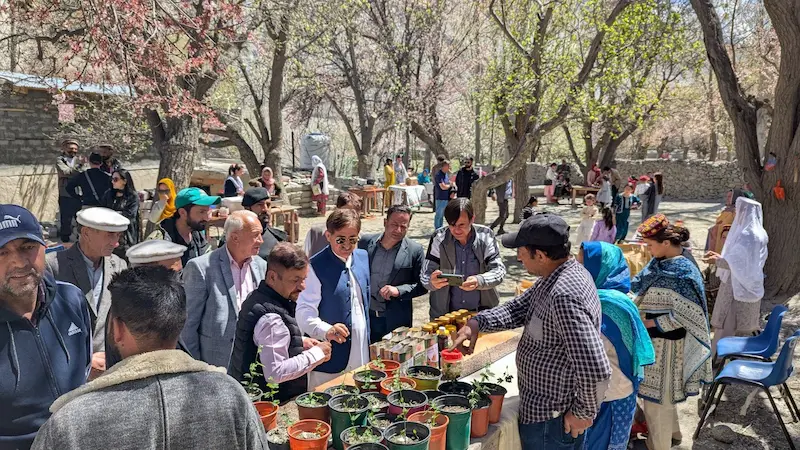
- Cherry Blossom Festival
Hunza’s most photogenic event, this celebration marks the arrival of spring when apricot, cherry, and apple trees bloom in shades of pink and white. Villages like Karimabad, Altit, and Ghulkin become natural floral corridors. - Navroz (Persian New Year)
Celebrated on March 21, Navroz marks the start of the new year according to the Persian calendar. In Hunza, it’s a day for traditional dishes (such as Diram Pitti and Harissa), community gatherings, and sports like polo and tug-of-war.
Summer — Harvests & High-Altitude Adventures
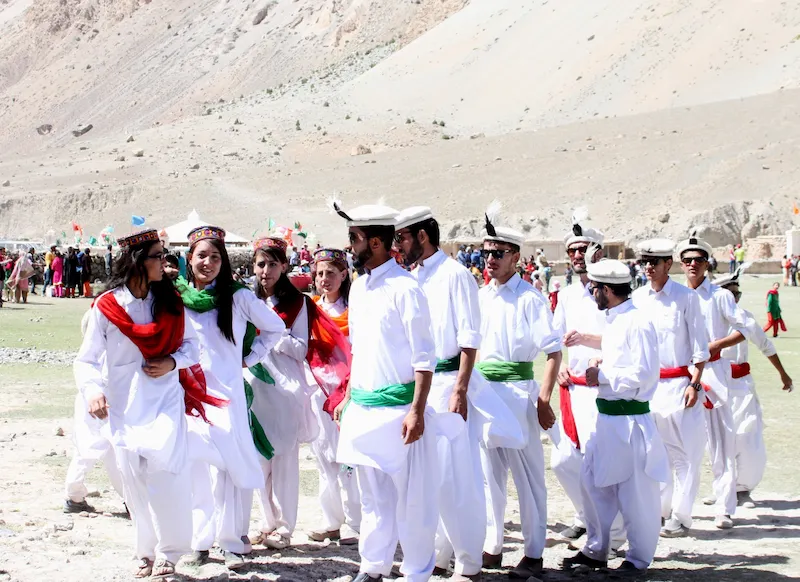
- Ginani (Harvest Festival)
Usually held in June, Ginani is a centuries-old celebration thanking nature for the year’s crops. - Baba Ghundi Mela
Taking place near the Baba Ghundi shrine in Chipursan Valley, this fair blends spiritual devotion with festivity. - Tour de Khunjerab
An internationally recognized high-altitude cycling race from Gilgit to Khunjerab Pass, peaking at over 4,700 meters.
Autumn — Culture & Golden Landscapes
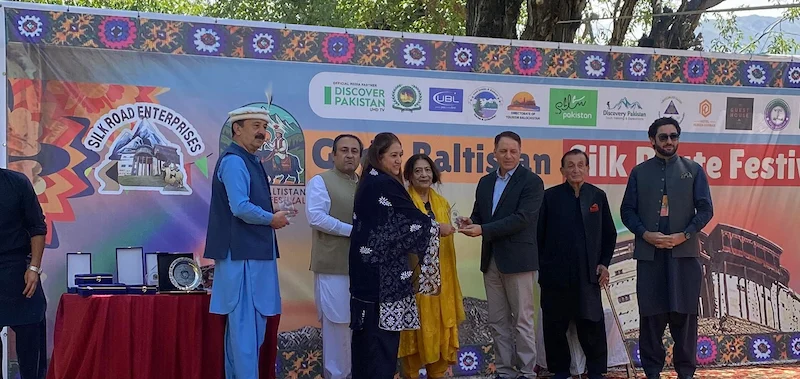
- Silk Route Festival
Celebrated across Gilgit-Baltistan, this festival honors the region’s heritage as a key stop on the ancient Silk Road. - Hunza Premier League (HPL)
Cricket fever takes over the valley in autumn, with local teams competing in scenic mountain stadiums. A community event that draws large, enthusiastic crowds.
Winter — Snow, Stories & Survival Traditions

- Karakoram Winterlude
A relatively new festival aimed at promoting winter tourism, featuring ice sports, frozen-lake skating, and winter photography contests. - Thumishaling
A traditional winter gathering where communities come together for storytelling, singing, and shared meals around a central fire.
Best Travel Tips Based on Season
Smart packing, the right accommodation, and a little planning can make your trip both smooth and unforgettable. Here are some best tips and recommendations to follow for best experience.
Packing List by Season:
- Spring (Mar–May): Light layers, windbreaker, comfortable walking shoes, sunscreen, camera for blossoms.
- Summer (Jun–Aug): Breathable clothing, sun hat, sunglasses, hiking boots, reusable water bottle.
- Autumn (Sep–Nov): Warm layers, fleece jacket, gloves for chilly mornings, sturdy shoes for uneven paths.
- Winter (Dec–Feb): Heavy down jacket, thermal wear, snow boots, gloves, hat, and extra socks.
Accommodation Choices:
- Summer: Opt for mountain-view guesthouses or best hotels in Karimabad and Altit.
- Winter: Choose hotels with heating, insulated rooms, and on-site dining since some roads may be snowed in.
Transportation & Road Safety:
- Summer roads are open, but always check weather before heading to high passes.
- In winter, only travel with local drivers experienced in snowy conditions; carry chains for tires if self-driving.
- Keep extra snacks, water, and power banks for long road trips.
Conclusion — Which Season Will You Choose?
Hunza Valley offers something unique in every season: vibrant blossoms and mild hikes in spring; lush green landscapes and adventure sports in summer; breathtaking autumn colors and cultural festivals in fall; and peaceful snowy scenes with winter festivities in the colder months.
Choose your visit based on what matters most to you, whether it’s family fun, romantic getaways, thrilling treks, or serene winter escapes.
Important FAQs
What is the best month to visit Hunza Valley for first-time travelers?
June to August is perfect for first-time visitors — the weather is warm, all tourist routes are open, and popular attractions like Attabad Lake and Khunjerab Pass are fully accessible.
Is Hunza Valley accessible in winter?
Yes, Hunza remains accessible year-round via the Karakoram Highway, but heavy snowfall between December and February can block side roads and remote valleys. Local transport is recommended for safe winter travel.
When is Hunza Valley most crowded?
The peak season is June to early September. Expect more tourists during school holidays, especially around Eid and Independence Day.
Which months are ideal for trekking in Hunza?
March–May and June–August are best for trekking, with routes to Passu Glacier, Rakaposhi Base Camp, and Rush Lake being accessible. Autumn is also great for short hikes.
Is April a good time to visit Hunza Valley?
Yes, April is the heart of blossom season. You’ll see cherry, apricot, and apple trees in full bloom, with pleasant temperatures for sightseeing.
Can I visit Hunza Valley in February?
Yes, but be prepared for sub-zero temperatures and snow-covered landscapes. It’s ideal for winter photography and cultural immersion but not for high-altitude trekking.
When does cherry blossom season start in Hunza?
Blossoms typically appear in late March in lower villages and peak in early to mid-April in Karimabad, lasting until late April in higher areas.
Which is better: visiting Hunza in summer or autumn?
Summer is ideal for family vacations, adventure sports, and full accessibility. Autumn offers fewer crowds, golden landscapes, and a more romantic, relaxed vibe.


